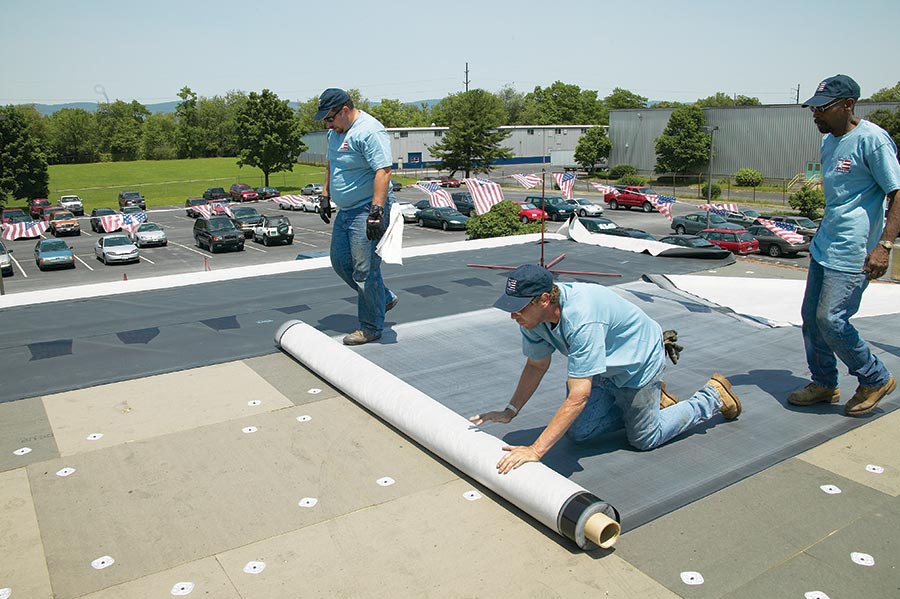Budget-Friendly and Professional Roofing by st louis roofing companies
Budget-Friendly and Professional Roofing by st louis roofing companies
Blog Article
How to Determine Common Roofing Troubles and Their Solutions
When it pertains to maintaining your roof covering, acknowledging common issues early can save you time and money. You may notice indicators like water spots, missing tiles, or even moss growth. Each of these concerns has details reasons and services that you should understand. Just how do you take on these troubles effectively? Let's check out the key signs and solutions that can help you secure your investment.
Signs of Roof Covering Leaks and Exactly How to Deal with Them
A leaky roofing system can transform your home right into a headache if not addressed promptly. You could notice water discolorations on your ceiling or wall surfaces, which typically indicate a leak. It's an indicator that dampness is trapped if you see peeling paint or mold and mildew development. Additionally, pay attention for trickling sounds throughout rain; that's a clear red flag.
To repair these problems, begin by situating the source of the leak. Inspect your attic for indications of wetness or water entrance. When you identify the problem location, you can secure tiny voids with roof concrete or caulk. For even more substantial damage, you may require to change shingles or even repair flashing. If you're not sure, constantly ensure safety first-- make use of a strong ladder and take into consideration hiring a specialist. Addressing leakages quickly can aid you stay clear of pricey fixings down the line and keep your home dry and safe.
Identifying Missing or Harmed Roof Shingles
When checking your roof covering, seek any type of missing or harmed tiles that can cause larger troubles. A visual inspection can reveal indicators of water damages, which might show that it's time to repair or replace those tiles. Dealing with these concerns early can conserve you money and time in the long run.
Visual Evaluation Techniques
To successfully identify missing or harmed roof shingles, start by conducting an extensive aesthetic evaluation of your roofing system. Get a set of field glasses for a better look, or use a ladder if you fit. Look for any kind of shingles that are curled, broken, or totally missing. Pay special attention to areas around vents, chimneys, and valleys, as these places are susceptible to damage. Search for granules in your seamless gutters or on the ground, which suggests wear. That might signify a problem if you notice any type of staining or uneven surface areas. Don't forget to examine the edges of your roofing system; broken or loosened tiles here can lead to bigger concerns. Normal inspections can help preserve your roof covering's honesty.
Signs of Water Damages
While examining your roof covering for missing or damaged tiles, look for indicators of water damages that can indicate underlying problems. In addition, examine the edges of your roofing and around chimneys for any kind of signs of rot or mold and mildew, which can hint at extended wetness direct exposure. Attending to these indicators early can protect against much more extensive damages and pricey repairs down the line, ensuring your home continues to be secured.
Fixing or Replace Choices

If you find missing or damaged shingles during your roofing examination, you'll need to make a decision whether to fix or replace them. If just a few roof shingles are affected and the remainder of your roofing is in excellent problem, a fixing may be all you require.
A brand-new roofing can improve your home's visual allure and power effectiveness. Always take into consideration the age of your roofing system and your budget when making this decision.
Identifying Sagging Roofs and Their Causes
Recognizing a drooping roof is essential because it frequently signifies underlying structural problems that call for prompt attention. Start by evaluating the roofing for noticeable indicators of drooping, like a bowing center or sagging eaves.

You should also look for signs of timber rot, which can compromise the structure better. It's critical to seek advice from a roofing professional if you suspect sagging. Early intervention can protect against expensive fixings and ensure the safety and security of your home. Do not wait; attending to the issue immediately can secure your financial investment and your satisfaction.
The Dangers of Moss and Algae Growth
Moss and algae growth on your roof isn't simply an eye sore; it can present serious carcinogen and bring about structural damage with time. These microorganisms can jeopardize your roof's stability and produce a reproduction ground for unsafe spores if left neglected. Let's explore exactly how to avoid and treat this issue effectively
Health And Wellness Hazards of Development
While you could value the natural appeal of moss and algae on your roof covering, it's crucial to comprehend the prospective health risks they posture. These growths can catch moisture, leading to a moist setting that advertises mold and mold. Exposure to mold and mildew spores can trigger breathing problems, allergies, and various other health troubles for you and your family. In addition, if you have pet dogs, they can additionally be influenced by the toxic substances released by certain kinds of algae. It is necessary to maintain your roofing system free from these growths to keep a healthy living environment. Regular upkeep and cleaning can help avoid their build-up, guaranteeing your home stays secure and your air top quality remains high. Do not neglect the value of a tidy roof!
Architectural Damage Dangers
If you let moss and algae flourish on your roofing system, you might be establishing the phase for major architectural damages. Over time, this moisture can compromise your roof covering's architectural honesty, making it a lot more vulnerable to leakages and various other problems. Neglecting these indicators not just risks your roofing system but additionally the entire structure of your home.
Prevention and Treatment Methods
Ignoring moss and algae can bring about significant issues, yet taking safety nets and treating any existing growth can protect your roof. Start by routinely cleaning your roofing to get rid of debris and moisture, as this develops an atmosphere for growth. Use a mix of water and bleach to carefully scrub the affected areas if you notice moss or algae. For avoidance, take into consideration setting up zinc or copper strips along the ridge of your roof covering; these metals prevent growth as rain washes over them. Additionally, ensure your roof has appropriate air flow to reduce wetness build-up. By staying proactive and dealing with these issues without delay, you can prolong your roofing's lifespan and preserve its stability, saving you costly repair services down the line.
Comprehending Roofing System Ventilation Issues
Appropriate roofing system air flow is important for keeping the honesty of your home, as it assists control click for more temperature and wetness degrees in the attic room. Without ample air flow, you may face significant concerns like mold growth, timber rot, and raised energy expenses. Examine your roof for indicators of inadequate air flow, such as extreme heat in the attic room throughout hot months or condensation creating on rafters.
You need to also look for unequal snow melting in winter, showing caught warmth. It's time to examine your air flow system if you discover any of these signs. Make sure you have a well balanced consumption and exhaust system, enabling fresh air in and stale air out.
You might need to add ridge vents, soffit vents, or gable vents to boost air flow. Normal upkeep and surveillance can protect against expensive fixings down the line, so don't overlook this vital aspect of your roof.

Exactly How to Place Roof Flashing Problems
Preserving great ventilation is just one component of a well-functioning roof covering system; roof flashing plays an essential function in maintaining your home secure from water damages. To spot flashing issues, begin by evaluating the areas where various roof areas satisfy, like vents, smokeshafts, and valleys. Try to find any type of visible gaps, corrosion, or peeling paint, which can suggest wear and tear. Inspect for fractures in the caulk or sealer that may enable water to seep with.
Additionally, analyze the flashing for any indicators of flexing or imbalance; these issues can endanger its efficiency. After hefty rainfalls, expect water spots on your wall surfaces or ceilings, as this may indicate flashing failing. If you notice any of these indications, it's important to resolve them without delay to avoid expensive damages. On a regular basis examine your flashing to assure it remains in excellent condition and executing its important feature.
The Significance of Normal Roofing Inspections
While it's easy to overlook, normal roof covering assessments are critical for preserving the integrity of your home. By setting up these inspections, you can catch prospective problems prior to they rise right into costly repair services. Assessors will recognize troubles like missing tiles, leaks, or wear around blinking that you may not observe from the ground.
You'll likewise take advantage of satisfaction, knowing your roofing system remains in good condition. Your roof protects everything under it, from your family to here your valuables. Routine evaluations can expand your roof covering's life expectancy and enhance its efficiency, conserving you cash over time.
Make it a behavior to examine your roof covering at the very least two times a year and after considerable weather events. Remaining aggressive concerning roofing maintenance assurances you address small concerns before they develop into major migraines. So, don't wait until it's far too late-- schedule your roof assessment today!
Regularly Asked Questions
Just how Frequently Should I Set Up Professional Roof Assessments?
You should set up professional roof assessments at least yearly. Nonetheless, after severe climate events, it's sensible to have an examination faster. Regular checks help capture potential issues before they escalate right into pricey repair work.
Can I Fix My Roofing Myself, or Should I Work with a Contractor?
You can try roofing repairs yourself if you're certain and have the right tools, but employing a specialist assures professional top quality and safety and security. Evaluate your skills and the project's intricacy before deciding.
What Are the Indications I Need a New Roof?
You'll understand white shingles on house you require a brand-new roof when you find significant leaks, missing out on shingles, substantial granule loss, or sagging locations. If your roofing's age goes beyond twenty years, it's time to contemplate replacement alternatives.
Exactly How Much Does Roof Repair Work Typically Price?
Roof covering fixing prices normally range from $300 to $1,500, depending on the damage and materials needed. You'll want to get numerous quotes to assure you're making the very best decision for your spending plan.
What Materials Are Finest for Roof in My Environment?
You ought to take into consideration products like asphalt shingles for modest climates, metal for longevity, and clay floor tiles in hot regions. roofing chesterfield mo. Each option has unique advantages, so consider your environment's specific demands and your home's style
When inspecting your roofing system, look for any missing out on or harmed roof shingles that can lead to bigger problems.To properly determine missing out on or damaged shingles, beginning by carrying out a detailed aesthetic examination of your roof.While inspecting your roof covering for missing out on or damaged shingles, look for indications of water damage that can indicate underlying concerns.If you uncover missing out on or harmed shingles during your roofing evaluation, you'll need to make a decision whether to fix or change them.Preserving good ventilation is just one part of a well-functioning roofing system; roof covering flashing plays a crucial role in keeping your home safe from water damages.
Report this page